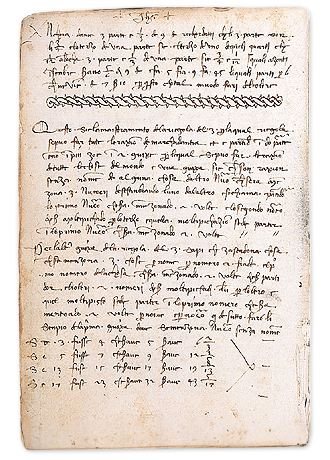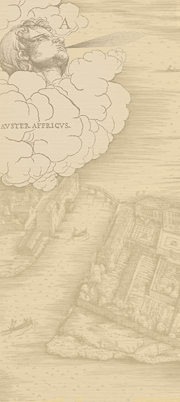Manuscript Viewer: Non Flash Version
Mathematics: The Rule of Three (p. 10a)

The rule of three was a fundamental mathematical tool in the Middle Ages and Renaissance, used to solve many practical commercial problems. The rule states that if four numbers are related such that a is to b as c is to d, then the fourth can be found by multiplying the second and third numbers together and dividing by the first, or d = cb/a. Michael regarded this rule as so important that he says it can be used not only to solve all mercantile problems, but "problems of all things of the world." He uses the rule of three repeatedly in the mathematical parts of his text.
See enlargement:
+ Ihesus + Anchora dame 3 parte e 1/3 de 9 lire. Rechordatti che li 3 parte son li 3/4 e lo terzo de una parte sie el terzo de uno de queli quarti ch'e 1/12. Adoncha 3 parte e 1/3 de una parte sie 3/4 e 1/12, i quali azonti insenbre serano 5/6 de 9 lire, e fa' 5 fia 9 fa 45, li quali parti per 6 che ne vien lire 7 soldi 10. E per questo chotal muodo fari dele oltre. Questo sie l'amaistramento dela riegola del 3, per la qual riegola se puo far tute le raxion de marchadantia et e partida in do parte e non in piu, zoe in 2 guixe per le qual se puo far le raxion de tutte le chose del mondo. E una guixa sie che son raxion senza nomen de alguna chosa d'altro numero che sera. Men- zona 3 numeri deschanbiando l'uno dal'altro, e se chiama partidor lo primo numero che sera menzonado 2 volte, e lo segondo nomero die 'ser moltipichado per lo terzo, e quella moltipichazion se die partir in lo primo numero che sera menzonado 2 volte. Per l'altra guixa dela riegola del 3 sapi che zascadona chosa che se menzona 3 chose per nome, per nomero 2 fiade. El pri- mo nomero dela chosa che sera menzonado 2 volte die 'ser parti- dor, e li oltri 2 nomeri die 'ser moltipichadi l'un per l'oltrro e quel moltipicho se die partir in lo primo nomero che sera mentoado 2 volte per nomen e per nomero. Qui de sutto faro l'in- senpio dela prima guixa dove se menzona numero senza nomen. Se 3 fusse 4, che serave 5? Serave 6 2/3. Se 5 fusse 7, che serave 9? Serave 12 3/5. Se 13 fusse 15, che serave 17? Serave 19 8/13. Se 17 fusse 23, che serave 32? Serave 43 5/17.
+ Jesus + 9.9.05 JW Then give me 3 parts and 1/3 of 9 lire. Remember that the 3 parts are 3/4 and the third of a part is the third of one of those quarters which is 1/12. Therefore 3 parts and 1/3 of a part are 3/4 and 1/12, which added together will be 5/6 of 9 lire, and do 5 times 9 makes 45, which divided by 6 comes to 7 lire 10 soldi. And in this way you will do the others. ********************************************************** Here is instruction in the rule of 3, by which rule can be done all of the problems of merchandise, and it's divided into two parts and no more; that is, in 2 ways by which you can solve problems of all the things in the world. And one way is that there are problems without the name of thing except the number that will be there. Men- tion 3 numbers, changing one for the other, and the first number that will be mentioned 2 times is called the divisor, and the second number should be multiplied by the third, and that multiplication should be divided into the first number, which will be mentioned 2 times. For the other way of the rule of 3, know that each thing that is mentioned 3 things by name, 2 times by number. The first number of the thing that will be mentioned 2 times should be the divi- sor, and the other 2 numbers should be multiplied one by the other and this product should be divided into the first number that will be mentioned 2 times by name and by number. Below I will give an ex- ample of the first way where a number is mentioned without a name. If 3 were 4, what would 5 be? It would be 6 2/3. If 5 were 7, what would 9 be? It would be 12 3/5. If 13 were 15, what would 17 be? It would be 19 8/13. If 17 were 23, what would 32 be? It would be 43 4/7.











